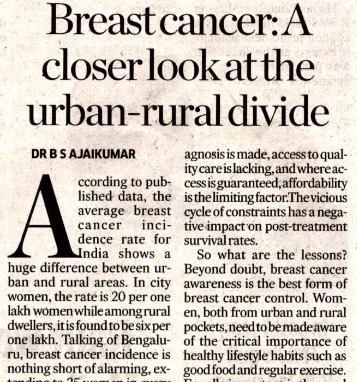
Breast cancer: A closer look at the urban-rural divide
According to published data, the average breast cancer incidence rate for India shows a huge difference between urban and rural areas. In city women, the rate is 20 per one lakh women while among rural dwellers, it is found to be six per one lakh. Talking of Bengaluru, breast cancer incidence is nothing short of alarming, extending to 25 women in every one lakh women. So what could be the root cause of this disproportion?
Sometime ago, a UK study revealed that women who live in urban areas tend to have denser breast tissue than suburban or rural women. Why was this finding significant? Because women with denser breast tissues were found to be at a higher risk of breast cancer. To be more specific, every 1 per cent increase in breast density was thought to increase the relative risk of developing breast cancer by 2 per cent.
Breast density, which seems to indicate breast size classified as fatty, actually tells us about the presence of more glandular breast tissue that tends to help breast cancer hide and grow within. The study was not conclusive, and it could not be established whether the urban environment accentuated the risk or whether it was a case of population issues. But it is clear that the urban population is at a higher risk. Why is that so?
In the context of breast cancer, several urban factors like sedentary lifestyles, little or no exercise, and a diet of junk food and alcohol have contributed to making obesity a number one concern, which in turn is the leading cause of breast cancer in women. Late marriages, childbirth after 35, and minimal breast feeding further complicate the problem.
The rural women are equally at risk, but for different reasons. In rural areas, women face a different set of factors: abject poverty, zero breast cancer awareness, fear of examination, and a host of social and cultural taboos.
As per a US study, women in developed countries survive roughly 10 years longer after a breast cancer diagnosis compared to women in low- to middle-income countries. Why? Because in the latter, as in India, there is an inordinate delay in screening, diagnosis, and treatment, which often prove fatal. In rare cases where a timely diagnosis is made, access to quality care is lacking, and where access is guaranteed, affordability is the limiting factor.The vicious cycle of constraints has a negative impact on post-treatment survival rates.
So what are the lessons? Beyond doubt, breast cancer awareness is the best form of breast cancer control. Women, both from urban and rural pockets, need to be made aware of the critical importance of healthy lifestyle habits such as good food and regular exercise. Equally important is the need to enhance knowledge about breast cancer, as well as its common symptoms and risk factors like family history, premature periods, delayed menopause, and obesity. Poor awareness leads to late detection.
For regions lacking in education, advocacy needs a more focussed and innovative communication strategy. Linked closely to awareness is the aspect of self-examination and screening. Since cancer is elusive and enigmatic, every woman should regularly do a self-examination, as she has the best innate awareness of her body and the changes within it. If women find any lumps or knots, they should immediately seek professional help.
Early detection not only improves patient outcomes, but also reduces treatment costs. Ideally, a clinical breast exam is needed every three years in the case of younger women, and every year for women over 40.
Women in India are generally diagnosed at more advanced stages, leading to a poor prognosis. Because breast lumps are often painless, many women who self-examine do not seek a clinical examination. So much of the agony can be avoided with a timely clinical examination.
As the WHO World Cancer Report 2020 has rightly observed, the most efficient intervention for breast cancer control is early detection and aggressive treatment. That cancer, if detected at stage zero, can be cured with lifestyle modification alone should be the biggest motivation for women to get regular examinations done.
Breast cancer is increasingly being seen as a lifestyle disorder. Precisely why there is an acute need for educating young women on various precautions that need to be taken, as also to effectively sensitise the high-risk populations.
The writer is Executive Chairman of a Bengaluru-based hospital